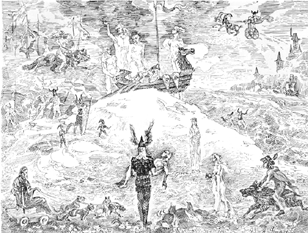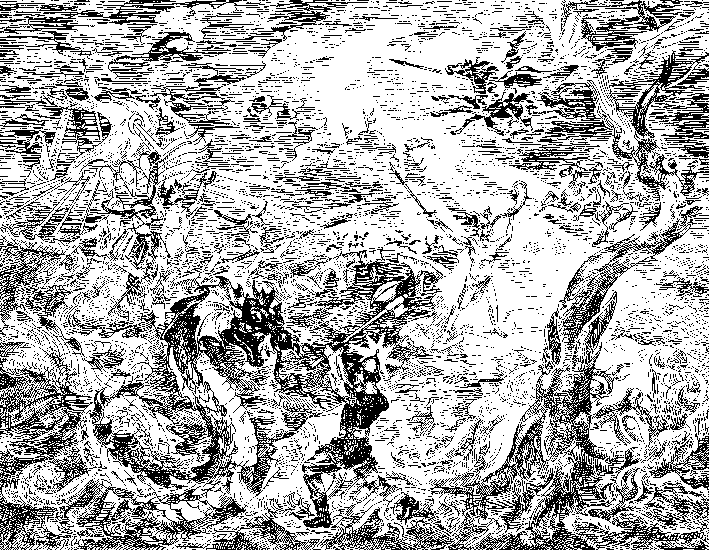|
|
|
Viking myths 2.

Baldur's burial. (A. Fantalov, the image in Indian ink).
Baldur - in the Scandinavian mythology the young god, favourite son of Odin and Frigg, was killed on intrigues demonic Loki. His death became turning point in "Edda". It was as a presage of destruction of the world. According to Viking tradition, thirst of gold will seize gods and people, they will shed blood and break oathes. Giants (trolls) will begin war against gods and this war will result in destruction of gods and giants and birth of the new world and mankind. This plot enables to represent characters of the Scandinavian myths who have together for the burial of the young god. Below, in the centre, Odin bears a body of Baldur to funeral ship. Baldur's mother Frigg has stiffened at some distance. On the right, there is Thor - mighty Odin's son (the Scandinavian god of the Thunder and the defender of people especially popular during Viking Age) on a heavenly chariot with goats. To the left from Odin - Freya, the goddess of beauty and love, "northern Aphrodite" (on a heavenly chariot with goats). To the right of tsar of gods her brother Freyr, on wonderful wild boar. They also arrived to a funeral ceremony. Valkyries, dwarfs, giants, people last time were going to honour died. Later they will again be left in fatal struggle.

The Scandinavian apocalypse. (A. Fantalov, the image in Indian ink).
Speaking about eshatology of ancient Scandinavians, it is necessary to mention that it finds out surprising similarity to similar plots of Zoroastrian Iran. Edda informs that "giant winter" which will come at the end of times. Chthonic monsters - World Wolf Fenrir and World Serpent Jormungand leaves the chasms and will be set on the world of gods. Giants will join them and demonic Loki, released from fetters. The gods and falling heroes from retinue Odin will beat against monsters and will win, but thus the majority of them will be lost. According to Persian sacral texts ("Frashegird") there will be great disasters at last centuries of the world. All wolves will be left together and will merge in one huge wolf. People will beat with it and will win. After centuries, all snakes will be slipped together and will grow together in the huge snake. And again, people will battle to it and will win. Will pass years and held down in a muzzle of a volcano Demavend threheaded serpeent Aji-dahaka, former is no time shah, will break off circuits and will escape on light. Then Supreme god Ahuramazda call up great warrior Keresaspa and that will strike a monster. Then Dives and other demons will be destroyed. Scandinavian and ancient Persian cultures have a line of the similar moments and besides eschatology. The plot about gold of dwarf Andvari, paid by gods is widely known as the repayment for death of his son, killed in an image of an otter. The damnation (the given plot has served as a begining to a history about Sigurd (Siegfried) and Nibelung) was imposed on this gold. And in Zoroastrian Iran above all animals the otter - "a water dog" was esteemed. For murder of an otter severe compensation in case of which default the person was cursed was imposed. But the attention and one fundamental psychological difference of the Iranian and Scandinavian mythology pays to itself. It is in the field of morals. Great sin for ancient Persians was the lie. Therefore, their shahs tried to not break already the made peace contracts (than, by the way, used the Romans, having concerning fidelity to agreements more free representations). As the guarantor of observance of the contract god Mitra - Indo-Iranian variant of the Cultural Hero acted. Scandinavians were not so scrupulous in the given question, and as we saw, an example in it their own Cultural Hero - Odin submitted.
King Arthur and Noble Knights 1. Menu